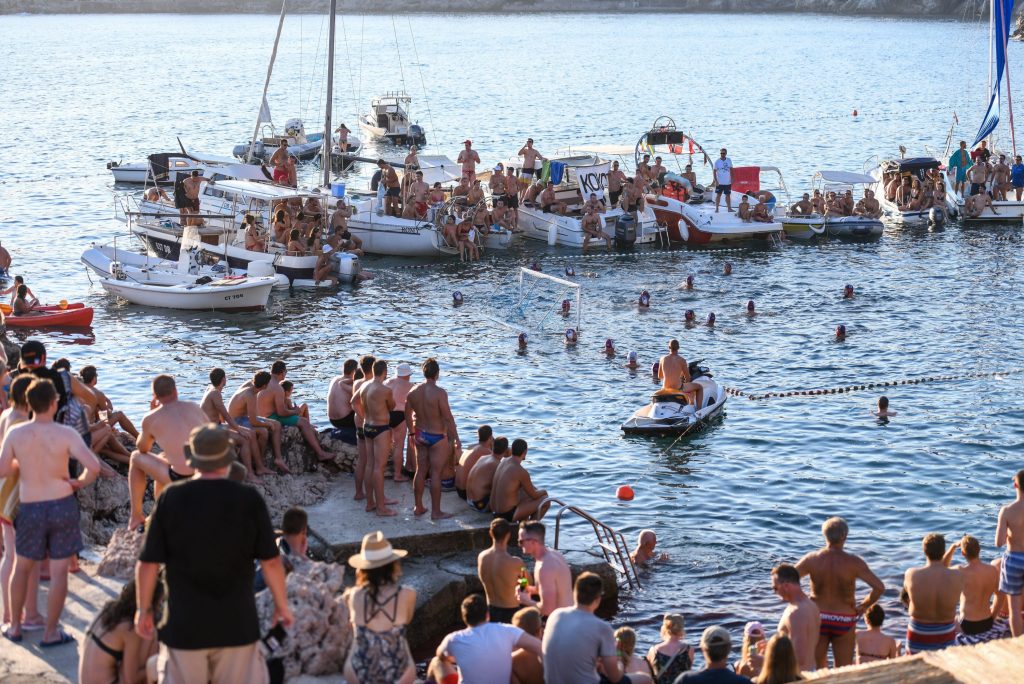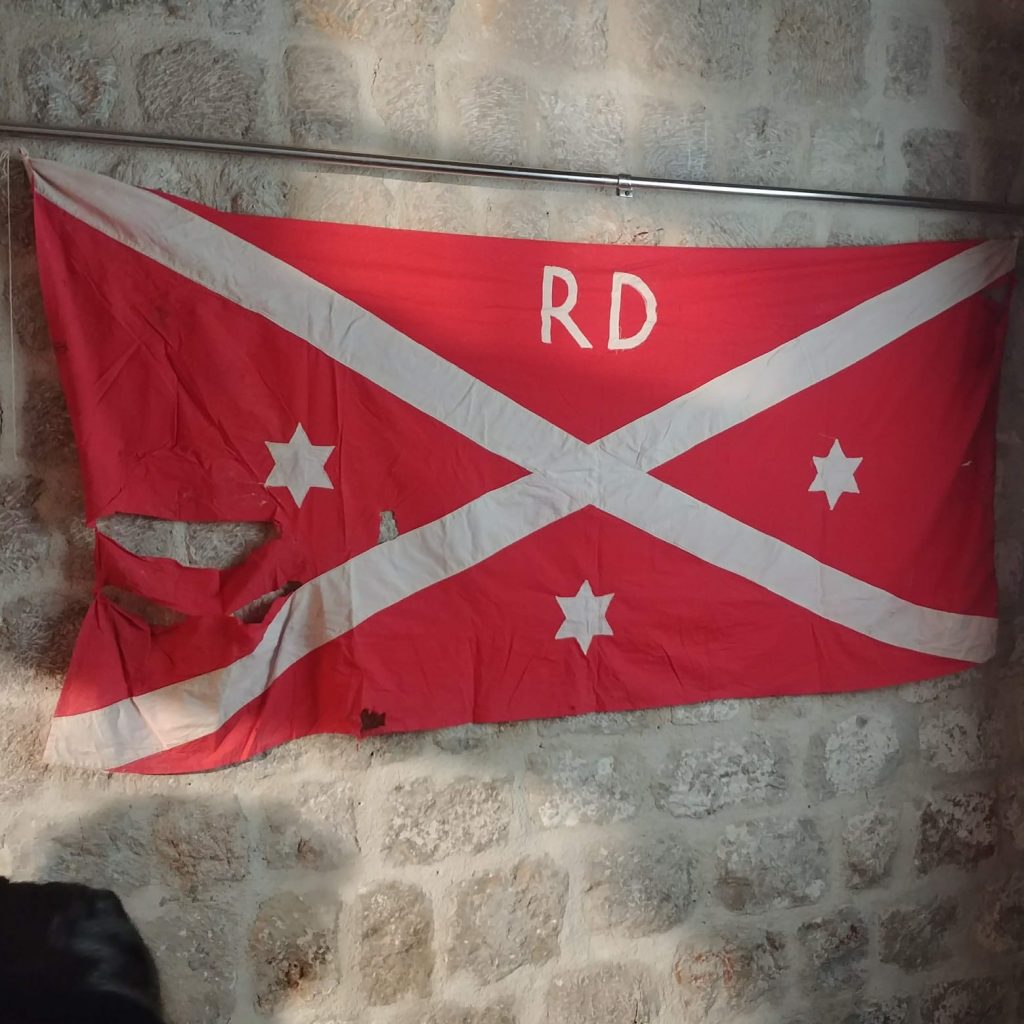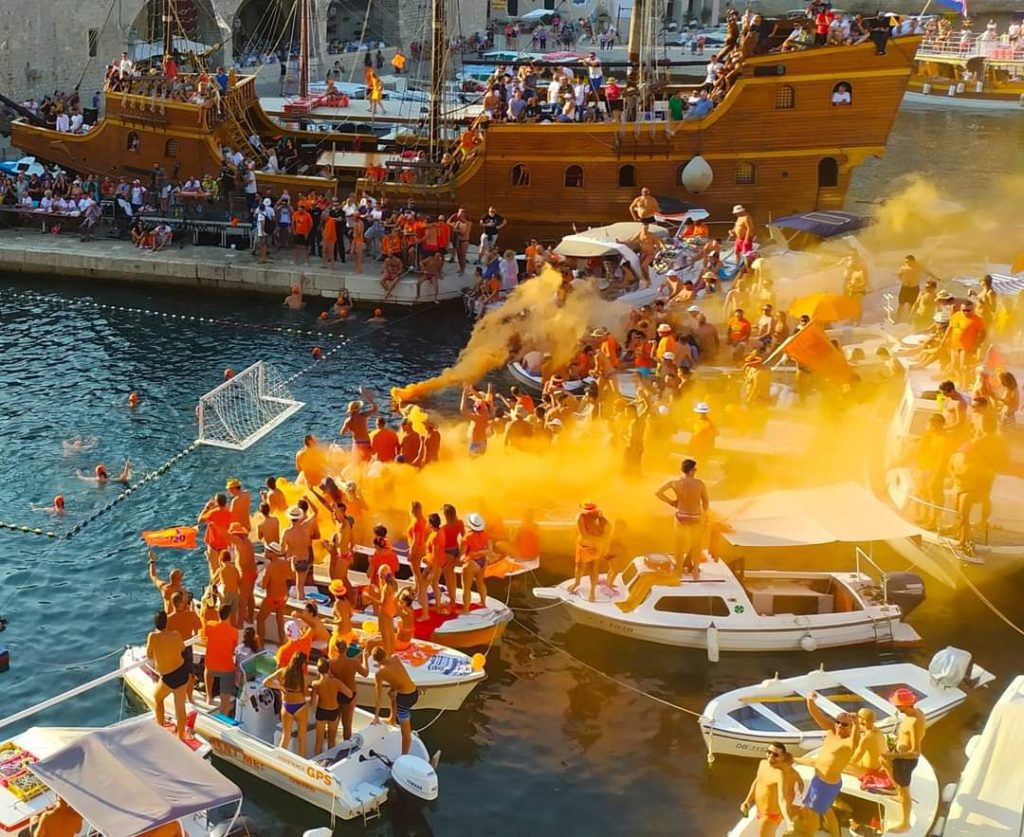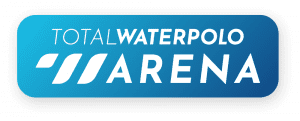Today, after the two years break caused by COVID-19 pandemics, one of world water polo’s most historic and traditional tournaments, the Wild League, gets underway in Dubrovnik.
A competition with one of the richest heritages in our game (which you can read read about below), the Wild League is a well-spirited tournament played against the backdrop of one of water polo’s most iconic venues – the Harbour in Dubrovnik.
The competition is a hugely significant event for the locals, with the event normally drawing a crowd of several thousand to feast on the spectacle.
Groups
Group A – Kamen mali, Porporela, Srebreno, Komarda
Group B – FUN H2O Mlini, PVG Gruški mul, Lukovica, Uvala Lapad,
Group C – Elita, Crvene stijene Orašac, Batahovina, Turčin Danče
Group D – Kokoti, Pasjača Popovići, Plaža ispod Petke and Lozica.

History of the Wild League
As soon as we mention the city of Dubrovnik in Croatia, we quickly conjure images of its illustrious cultural and historical past. St. Blaise, the walls, and Stradun all come to mind, but so does water polo.
As far as Dubrovnik water polo goes, ‘The Wild League’ has its own story. The story begins in the twenties of the twentieth century, about a century ago. After the First World War, there were discussions about re-establishing the Dubrovnik Republic, which had been abolished by Napoleon’s France 110 years earlier.
Dubrovnik’s young residents began congregating around Dubrovnik’s bathing resorts on hot summer days and vacation days. The ‘Danče Republic,’ ‘The Republic of Porporela,’ ‘Pile Kingdom,’ ‘Kingdom Banje,’ and ‘Kingdom Kolorina’ were the most well-known. Every single one of them has a unique set of rules and regulations that included everything from their colours to their songs to their rituals. In their latter years, they all also had their own water polo teams.
They started a number of water sports competitions and festivals. In the summer of 1919, ‘The Republic of All Danče’s‘ was declared as the most well-organized. The ‘Wild League’ was born out of these water polo teams’ meetings. VK Jug had its genesis in these groups.
The teams (Republics and Kingdoms) competed against each other in individual matches before World War II. The first championships were held in the ’50s of the previous century. Unfortunately, only two sets of results have been saved: Porporela’s from 1950 and Piplic’s from 1959.
After years of inactivity, the tournament was revived in 1983 and has continued for the past 40 years. Even the Association’s financial operations were the subject of controversy about ten years ago. As a result, there were two Wild Leagues in 2012, one for each month of the year.
Water polo is a unique sport, and the fact that so many media outlets cover it attests to its significance. There are also national and international aspects to it. As an example, German Bild listed the Wild League in their 2005 list of 100 absolutely unique world sports events.
It was founded in 1923 by Sports Club Jug. Sports Club Penatur made its debut in the following year. Rudi Reš, a 27-year-old world-renowned swimmer and water polo player, also visited Dubrovnik in the same year.
Reš picked the Danče young squad since it was the most well-organized in terms of athletics. He began training them by teaching them the rules of water polo. During his time at VK Jug, he served as a coach and player, as well as a football player. They owe him a lot, and they still respect what he’s done for the sport in Dubrovnik.
On the occasion of his 50th and 40th years in Dubrovnik, he was honoured with a party in 1963. Even now, the best water polo player in Croatia has his name. And we can see how effective Reš teaching was for many years after his death.
Penatur got its start with ‘Pile Kingdom,’ just like VK Jug did. Early in 1924, it was established with the goal of fostering swimming as a sport (swimming, water polo, diving, and jumping). Summer sports celebrations were also on the agenda. Only residents of Dubrovnik were allowed to participate in their tournaments, unlike Danče’s.
Both of these groups were among the first to sign up. Porporela was chosen as the neutral venue for the first ever meeting between swimming and water polo on June 28, 1924. Jug prevailed 3:0 in the match. Braid scored all three goals, making him a part of the annals of water polo history.
Following this, Dubrovnik played its first international match on August 3, 1924. Against the English fleet, Penatur’s players were given the opportunity to compete.
England was the best water polo team in the world at the time. Considering they missed the Games in St. Louis., they’ve managed to win four of the five Olympic games they’ve participated in. It’s intriguing that Paolo Radmilović, the captain of the English squad and a four-time gold medallist, was born in Dubrovnik. The game between England and Dubrovnik was won by the English team in the end.
Danče Republic
The Gradac park is home to Danče, the birthplace of VK Jug, one of the world’s most dominant water polo teams. It was largely forgotten during the Dubrovnik Republic (1457). the ‘Gospa od Danača’ church was established by the Dubrovnik Republic Senate in 1644 for the Franciscan sisters’ care of those in need.
Many republics and kingdoms were established in Dubrovnik’s bathing holes after the Austro-Hungarian Monarchy fell.
‘The Free Independent Republic of Whole Danče’s’ was established in 1919 and was the first state to do so. There were strict guidelines on everything from the borders to the flags, crest and emblem to even the colour of their army’s hats.
The players of VK Jug were regarded as ‘people of the Republic’ at the time of its inception.. Since then, VK Jug has carried the colours and anthem into the present day.
When asked about the Republic’s relevance, three men in their 20s said:
Prof. Zdenko Šapro:
“In the years leading up to the founding of Jug, I frequented a number of swimming spots, the most frequent of which was Danče’s. All of the Republics have a peaceful coexistence, with nothing to upset the tranquilly. The Danče Republic was the most common. The imagination of the hedgehog and Kakumuk (the primary deity in Danče mythology) was accentuated by youngsters.”
Marko Dabrović:
“The Danče’s hymn was given an English melody by Kolja Jovanovic. He visited Dubrovnik for a short time and was known as ‘the chief of the tapiti’ (one of the three municipalities of the Republic). I still recall the evenings in Dančes we spent in preparation for the rituals. Throughout the school year, there was always a tinge of sportsmanship. Swimming, diving, games of sinking, and jumping into the sea from slippery rocks were some of the activities we engaged in.”
Ivica Dabrović:
“I, too, had to keep Danče away from other countries. The rituals were always a priority for us. When foreign monarchs came to visit, they wore the Republic’s crest, which I still have. I also have the oldest flag belonging to Danče. I remember the battles we fought to protect Danče. However, on August 10 (St. Lovrijenac) — the day when all the Republics came together in Kolorina for the celebration — the war states were always put on hold.”
Youth’s lives revolved around their participation in this Republic, as evidenced by these testimonies. In addition, after Rudi Reš linked up with VK Jug, several people who weren’t originally from Danče joined the squad.
After then, intensive training under the leadership of enthusiasts and experts began. Mirko Braida scored the first three goals in Jug, and it’s widely accepted that he was the shooter. He was a member of “Kingdom Banje” that joined Jug after scoring a goal against Penatur.
The team used to practise in Danče until 1961, when a pool was built in Gruž. VK Jug evolved into an international and national championship-winning squad, but Danče persisted. The Wild League was born in 1983 as a result of Danče and Porporela’s encounters.
A handful of young and old men continue to carry on this practise. These summer events are known as ‘Danče’s Summer’ and include water polo tournaments, card games in the sea as well as Danče’s football as well as a swimming marathon. It’s been 90 years since Danče’s death, but her spirit lives on.
VK Jug
It all began with Rudi Reš’ arrival in Dubrovnik, Danče, in the summer of 1923. Soon after their first match in June 1924, they began playing in the neighbourhood with their first neighbours, the Penatur from Pila (against Jadran from Herceg Novi, for example). Jadran waited patiently for a match in September. With Danče taking home a 2-1 victory in the old-town port, the game was close but fair.
Jug began competing in national competitions the following year (1925). Prof. Milivoj Petković says in his blog that the majority of the performances took place in Split and that:
“Three-time national champion “Somborsko sportsko druženje” was Jug’s first opponent, and they won by a goal differential. Croatian “Jadran,” who was aiming to win back the 1924 champion title, had a pivotal match against the United States. A Zdenko Šapro goal gave Jug’s young team (all under the age of 20) a surprise 1-0 lead.
After that, they continue with a smaller roster due to the absence of Dubrovnik’s player. The jug is unyielding. Zdenko Šapro scores once more as they score their second goal of the game. The referee Malešević ended up in the sea as a result of this. Jug returned home after the match was called off.
Because of a decision by the Swimming Association, the championship couldn’t be completed in Dubrovnik. Due to Jadran’s lack of attendance, Jug was declared the victor. Dinko Fabris, Marko Dabrović, Ante Zaharija, Ivica Dabrović, Rudi Reš, Mirko Braida, and Zdenko Šapro won the inaugural national championship title.
Because it was Dubrovnik’s first championship, their names will live on in gold letters in the city’s sporting history. The national champs then went on a 13-game winning streak.”
VK Jug’s ‘The People of All Dančes’ also included all of the players on this list. For many years after the death of the Republic of Danče, Jug’s matches were still marked by the flag being hoisted. Half of the spear was used in the event of defeat.

Republic of Dance original flag
Građanski, GOŠK, and Neptun were also represented at the national championships, in addition to Penatur and VK Jug.
In records from that period, ‘the whole of Dubrovnik’ waited for them on the banks of the port Gruž to show their admiration and celebrate with them when Jug returned to Dubrovnik.
It wouldn’t be long before Jug had won 13 national championships, with Split’s Jadran serving as their major competition. They were never really in love with one other. On Sušak, Jug defeated Jadran 7-0 in 1933. Jug has never had a better moment in his life. The boat they took to get back home had a 7-0 odds written all on it.
There was an escalation in the situation as time went on. When the junior championships were held in Split in 1937, Jug decided to skip the event. Jadran, Viktorija, and Ilirija, on the other hand, propose the adoption of leagues rather than the cup. As a result of this, the championship was boycotted by the rest of the clubs.
Jug retaliates with a boycott, bringing an end to their 13-year streak of national championships. When the league system was first implemented in 1939, the second-place finish went to Jug. Jug won the title again in the final competition before World War II. Since 1930, new competitions have been introduced, and Jug has amassed eight titles, two silvers, and boycotted the league once during that time period.
When playing the toughest European teams of the time, Jug put its strengths to the test. In 1933, two Hungarian teams played a match in Dubrovnik. The score was 3-0 for Jug and 4-1 for them in their victory over MTK. After that, they defeated UTE, the Hungarian champion, by scores of 4-3 and 6-0. The entire city of Dubrovnik erupted in joy after the 6-0 win. They nevertheless pushed Jug out of their league and into the globe.
Due to its growing popularity and Dubrovnik’s dedication to it, water polo became the city’s most important sport. Since they had dominated for 13 years with mainly local players, this was inevitable.
At the time, the Yugoslav water polo squad was largely comprised of Dubrovnik players. Jug had 19 of the 43 players in the tournament. On August 28, 1937, Jug’s entire team represented the national team trounce Czechoslovakia 3-2. There were 13 regional championships won by that very same winning team.
Following WWII, Jug won three straight titles (1949-1951), after which their results dramatically declined. While initially the absence of pools was a big issue, competitor clubs with superior training facilities emerged. Partizan Belgrade is a particular favourite of mine. In 1980, Jug returned to prominence after a long absence.
Over the course of six years, they racked up five championships, including the inaugural Champions Cup trophy. A debut in a European clubs competition, this was the first match for the team. The gold medal went to Đuho, Sukno, and Vuletić. By the end of Yugoslavia’s existence, Jug remained the most trophied water polo club, with 22 national champions titles.
In the aftermath of the War of Independence, the level of sports deteriorated once more. In addition, the team was adversely affected by its location in Dubrovnik. After a few years of restructuring though, Jug was able to return to its former glory. Jug has won 17 Croatian championships in the last 23 years. Three European Champions titles are also awarded. There were 6000 people in attendance for the first Gruž competition in 2001.
Since Jug relied primarily on local talent, this is especially relevant in today’s worldwide economy. The Croatian national team has accomplished a great deal during the previous 15 years, including the World Champion title in 2007 and 2017, the European Championship Gold in 2010, and the Olympic gold medal in 2012.
Jug was the driving force behind all of these victories. They are Frano Vićan, Andro Bušlje, Miho Bošković, Maro Joković, Nikša Dobud, Sandro Sukno, Paolo Obradović, Marko Bijač and Loren Fatović.
‘The Wild League’
The Wild League was founded out of Dubrovnik’s love and admiration for water polo. Everyone in Dubrovnik, it is said, has played in Jug at least once during the summer. Even those who have never tried it in a bar can enjoy the games and the spectators on the beaches. Players that thrive in such an environment are destined to be the best in the world.
This is a topic we touched on earlier when discussing the importance of a team’s performance against its neighbours in the early twentieth century. As a result, Jug has been in charge of overseeing all of the games and competitions since World War II.
Even though it wasn’t an official tournament, the Wild League was held in the City and was arranged in league manner. So, today’s name is a direct descendant of Dubrovnik’s water polo heritage.

We know for sure that Porporela won the 1950 championship and Piplić in 1959, but there isn’t much else to go on. Even though professor Dobroslav Zanini, claims that the Leagues were played until 1961, when they were relocated from the harbour to the pools. Local leagues ceased to exist following the relocation.
1983 marked the year of the inaugural game of the contemporary Wild League, as it came to be known. The only native at the time was Dubrovački Vjesnik, who founded the group. When it came time to organise the competition, Sports Editor-in-Chief was in charge of it. The Wild League has published 40 issues since its inception, with the exception being 1992 – the year in which the city was attacked by Montenegro-Serbian forces.
Wild League was still significant to the people that year, so they staged a symbolic game to demonstrate that. Many of those who attended were dressed as soldiers. Despite conflict and hard times, people continued to play these games.
In 1983, there were ten teams and five days of competition. The ’83 edition was won by Bellevue ’73. Throughout the years, the entire league was sometimes referred to be a massive game between Dančes and Porporela.
The finals, on the other hand, were exactly that. When the league convened in Dubrovnik, it was a raging success. Boats from all around the world were arriving. Sirens, trumpets, and drums could be heard. All the while, Crna Udovica’s songs were playing. Grilling 20 kilos of fish with help from Zlatko Čerjan, Periša Obradović and Goran Čolak . You were sure to find a drink or something tasty to eat there.
Murat Avdić, a shaky-voiced official spokesman, was announcing new terms. The game was tied 5-5 at the end of the half. Bellevue ’73 then went on to win 7-5. After the match, everyone, both the winners and losers, had a good time. This didn’t require a passion for water polo to appreciate. It was more than just a Wild League, – an idea that everybody present agreed on.
And so it went on. Over time, the Wild Leagues developed a more professional appearance. Tonči Vlašić arrived in Dubrovački Vjesnik after the War of Independence and took over the league’s organisation. Until then, the onus of making judgments rested solely on the eight teams involved.
When the Wild League’s new rule went into effect in 1990, the Jug players were no longer permitted to compete there. The players might, though, if they wished, join the League once they finished their professional careers.
During the past two decades, there have been increasing regulations. In the first place, only people who were born or now reside in Dubrovnik are eligible to join the League. In addition, the game’s core gameplay has undergone a number of alterations.
The championships have been held in Porto for the last 20 years – a place where Jug played before the pools were established. It’s an honour for each athlete to get the chance to perform in such a historic venue. In front of Dubrovnik’s most revered landmark, St. Blasius Church, where athletes were greeted with cheers and awarded medals.
After the first 10 teams in 1983, the number of teams fluctuated slightly. There were just seven teams in 1987. However, Jug’s accomplishments at other national and international competitions reignited interest in water polo.
There were 16 clubs in the league by the 1990s. The following year, there were twenty. There were 40 teams competing at the start of the 21st century, and by 2005, the Wild League reached a new high with a record-breaking 46 teams.
The number of participating teams in the Wild League has dropped though over the last ten years:
- – 42 teams
- – 39 teams
- – 32 teams
- – 30 teams
- – 29 teams
- – 25 teams
2018. – 25 teams
It’s enough to say that the finals had an audience of 2-3 thousand people and the Wild League is still the most watched water polo event in Croatia (except from EC that will be played in Split this summer).
We mentioned Tonči Vlašić, who was organizing the event for the last 3 decades. He established cooperations with the local community, city, and county. The draw for the League is held in a prestigious ambient with often famous athletes coming. This way, the word of the Wild League spread out. To mention name some: Ivano Balić, Goran Ivanišević, John McEnroe.
Apart from Vlašić, who was in charge of the organisation, places, and qualification, there are also the players and teams helping out. These teams are Danče, Šulić, Porporela, Plat, Mlini, Čilipi, Cavtat, Mokošica, Orašac… They maintain the terrains which are set in the sea for the whole summer. Every team use them to practice and play in the Wild League.

Socializing and having fun take precedence over the game itself and its historical significance. The old regulation of only allowing certain teams to participate in the League has been repealed. Since the tournament has grown in size, there are more teams participating, and some compete for the prize money while many others simply enjoy the sport.
Every year a new show is put on by teams like Berdova Vila despite the fact that they haven’t won in seven seasons in the League. Additionally, Turčin Danče has the most up-to-date strategy for the games. The video, photo, and reporting background for each play is available online.
These groups are getting on in years, and as a result, their energy level has dwindled. However, a documentary is in the works.
Wild League water polo competition in Dubrovnik is unusual. With this in mind, organiser Vlašić stated:
“Today’s Dubrovnik water polo fandom has its roots in Jug’s early years of play. They’d won the national championship 13 times in a row. These impressive outcomes sparked widespread interest, which has persisted to this day.”
Water polo is a difficult sport to play, even as an amateur, if you haven’t played it since you were a kid because of the unique physical requirements. These large amateur events are so well-attended because of this same reason. To begin with, it’s the success of it that draws new players, particularly young ones, to the sport.
All of this does not happen in a single day. In the summer, Dubrovnik’s swimming holes were a popular gathering spot for the city’s young. Teams began to develop as they competed. The Wild League’s origins can be traced back to these events.
With so many people playing water polo, it’s critical to have a spark that ignites the whole thing. Among the Wild League’s notable figures were Rudi Reš’, the league’s instigator, and Toni Vlašić – the person who took the league to the next level.
Previous Winners
2019 – Kamen Mali
2018 – Elita
2017 – Fun H2O Mlini
2016 – Elita
2015 – Kamen Mali Cavtat
2014 – Fun H2O Mlini
2013 – Kamen mali (Cavtat)
2012 – Montovjerna
2011 -Špilja ’94. Danče
2010 – Penatur
2009 – Solitudo
2008 – Solitudo
2007 – Porporela
2006 – Palace
2005 – Montovjerna
2004 – Copacabana
2003 – Montovjerna
2002 – Špilja ’94 Danče
2001 – KIKS 04
2000 – KIKS 04
1999 – Bellevue ’90
1998 – Copacabana
1997 – KIKS 04
1996 – KIKS 04
1995 –
1994 – Roxy
1993 –
1991 – Copacabana
1990 – Gjivovići Dolphins
1989 – Roxy
1988 – Copacabana
1987 – Student
1986 – Čingrija
1985 – Danče
1984 – Danče
1983 – Bellevue 73
1959 – Piplić






